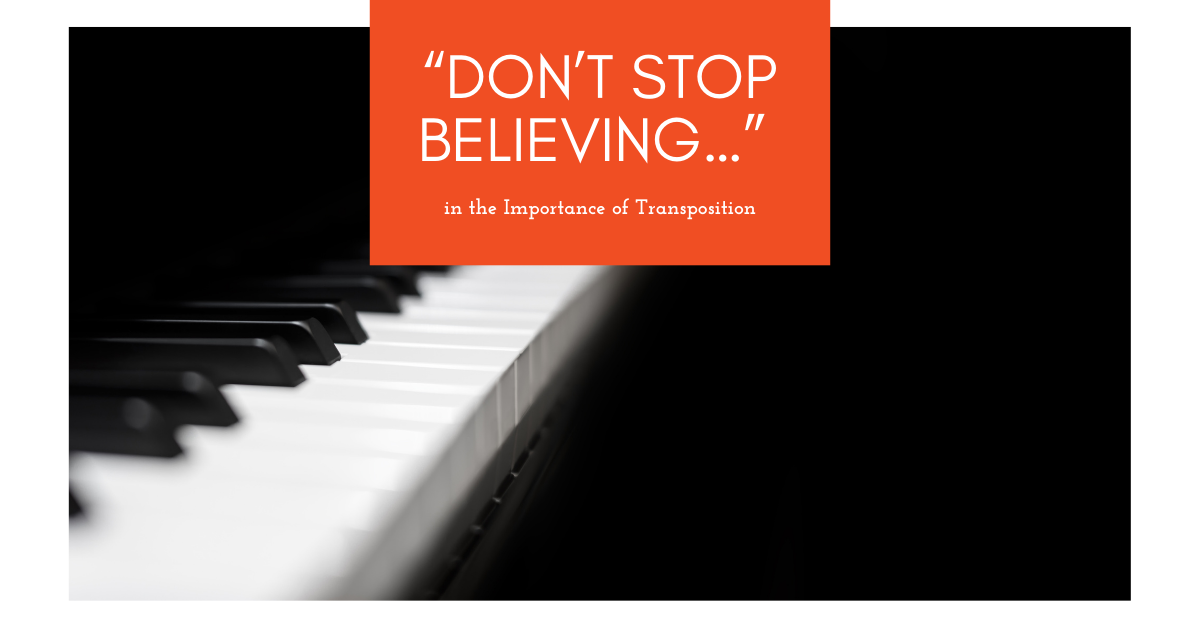"Don't Stop Believing..." in the Importance of Transposition

"Don't Stop Believing" by the band Journey is perhaps one of the greatest and most popular rock songs of all-time. And as most keyboard players who have had any experience in playing in a cover band will tell you, it gets played at almost every bar gig, wedding, or party. Basically, it's a "must-know" tune for every keyboardist out there who wants to call him/herself a fan of rock (and the same is true for you guitarists, drummers, and bass players, too). I am absolutely not exaggerating when I say that I have in all likelihood played this song about 500 times in the past few years (mostly with wedding bands, but occasionally with well-known artists who still enjoy covering this classic anthem). I've played it so many times it's been burned into my memory. I couldn't make a mistake playing this song if I tried, right? Wrong.
A couple years ago I remember being on a gig and the band was sound-checking prior to the performance. The singer said "Hey, do you guys all know 'Don't Stop Believing' by Journey?" to which the band groaned, "uhh, yeah." We all knew it so we didn't bother wasting time rehearsing it. Well, this singer had a particularly gritty, gravelly, blues-rock type of voice, so I should have guessed that he wouldn't be singing in the original key. But it wasn't until we were about to play the tune on stage that the bass player leaned over and discreetly informed me, "hey, he does this tune down a minor third, in the key of Db major." The original, of course, is in the key of E major.
Now, I'm not claiming to be any musical genius because I was able to transpose "Don't Stop Believing" and all of it's pioneering harmonic advancements down a minor third. But I will tell you that, as many times as I've played this tune and should have been able to do this in my sleep, I had a moment of real fear as I realized I had about 5 seconds to start playing this tune in Db. As anyone who has listened to this song knows, simply playing the right chords is not enough. The piano intro is iconic and needs to be played with the right voicings of the chords. So I did a quick harmonic analysis in my head of what I was about to play, found my starting chord and the proper voicing, and started the intro... and hit a bum note about 3 chords in that I thought was pretty foul (but I don't think anyone else noticed it, luckily).
So what is the moral of the story? Practicing the skill of transposition is very important, even in the rock world, and especially when working with singers because different singers oftentimes will sing the same tune in different keys. I've worked with many singers, but I don't think I had ever played "Don't Stop Believing" in a key other than the original. Let's quickly break down the intro to this classic rock hit and gain some insight into how to think about moving it to another key.

Notice a few important things right away. First, the chords are moving at the rate of one measure per chord. Second, the chord progression is very easy and all diatonic - I, V, vi, IV. My first step in the process of transposing this progression to Db major is to simply find the I, V, vi, and IV chords in this new key.

My next step is to find the proper inversion (or voicing) of the chords. As mentioned above, the piano intro is very well-known, so it is not enough to simply play the right chords because they also need to be expressed using the proper voicing. As I look at the original in the key of E, I notice that the first chord uses the 5th as the highest note in the voicing.

I need to find that same starting position in the new key of Db major.

Being familiar with the original version certainly also allows my ear to find and hear the correct note choices. See if you can use both your ear and your transposition skills to figure out the bass line for these first 4 measures of the song in the key of Db major.